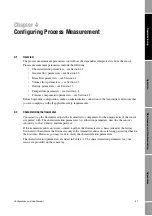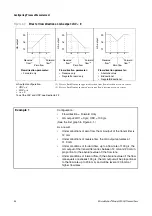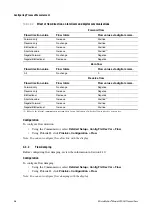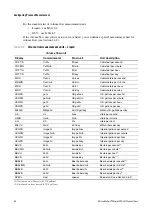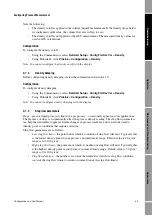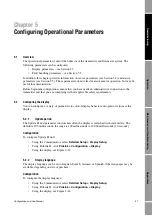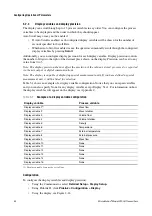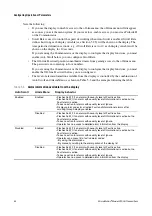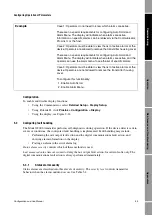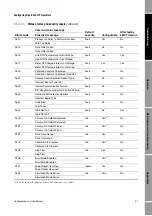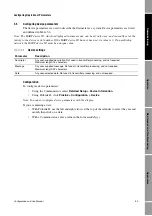
Configuration and Use Manual
45
Configuring Process Measurement
Op
eratio
n
App
e
ndi
ces
Mai
n
tenan
c
e and
T
roub
le
sh
oo
tin
g
Com
m
is
si
on
in
g
Note the following:
•
The density cutoff is applied to the volume (liquid) measurement. If the density drops below
its configured cutoff value, the volume flow rate will go to zero.
•
The density cutoff is not applied to the GSV measurement. The measured density values are
used in GSV calculations.
Configuration
To configure the density cutoff:
•
Using the Communicator, select
Detailed Setup > Config Fld Dev Var > Density
.
•
Using ProLink II, click
ProLink > Configuration > Density
.
Note: You cannot configure the density cutoff with the display.
4.7.3
Density damping
Before configuring density damping, review the information in Section 4.10.
Configuration
To configure density damping:
•
Using the Communicator, select
Detailed Setup > Config Fld Dev Var > Density
.
•
Using ProLink II, click
ProLink > Configuration > Density
.
Note: You cannot configure density damping with the display.
4.7.4
Slug flow parameters
Slugs
– gas in a liquid process or liquid in a gas process – occasionally appear in some applications.
The presence of slugs can significantly affect the process density reading. The slug flow parameters
can help the transmitter suppress extreme changes in process variables, and can also be used to
identify process conditions that require correction.
Slug flow parameters are as follows:
•
Low slug flow limit
– the point below which a condition of slug flow will exist. Typically, this
is the lowest density point in your process’s normal density range. Default value is 0.0 g/cm
3
;
range is 0.0–10.0 g/cm
3
.
•
High slug flow limit
– the point above which a condition of slug flow will exist. Typically, this
is the highest density point in your process’s normal density range. Default value is 5.0 g/cm
3
;
range is 0.0–10.0 g/cm
3
.
•
Slug flow duration
– the number of seconds the transmitter waits for a slug flow condition
(
outside
the slug flow limits) to return to normal (
inside
the slug flow limits).
Summary of Contents for 2200S
Page 8: ...vi Micro Motion Model 2200S Transmitters ...
Page 12: ...4 Micro Motion Model 2200S Transmitters ...
Page 32: ...24 Micro Motion Model 2200S Transmitters ...
Page 38: ...30 Micro Motion Model 2200S Transmitters ...
Page 68: ...60 Micro Motion Model 2200S Transmitters ...
Page 92: ...84 Micro Motion Model 2200S Transmitters ...
Page 102: ...94 Micro Motion Model 2200S Transmitters ...
Page 110: ...102 Micro Motion Model 2200S Transmitters ...
Page 130: ...122 Micro Motion Model 2200S Transmitters ...
Page 134: ...126 Micro Motion Model 2200S Transmitters ...
Page 150: ...142 Micro Motion Model 2200S Transmitters ...
Page 156: ...148 Micro Motion Model 2200S Transmitters ...
Page 157: ......

